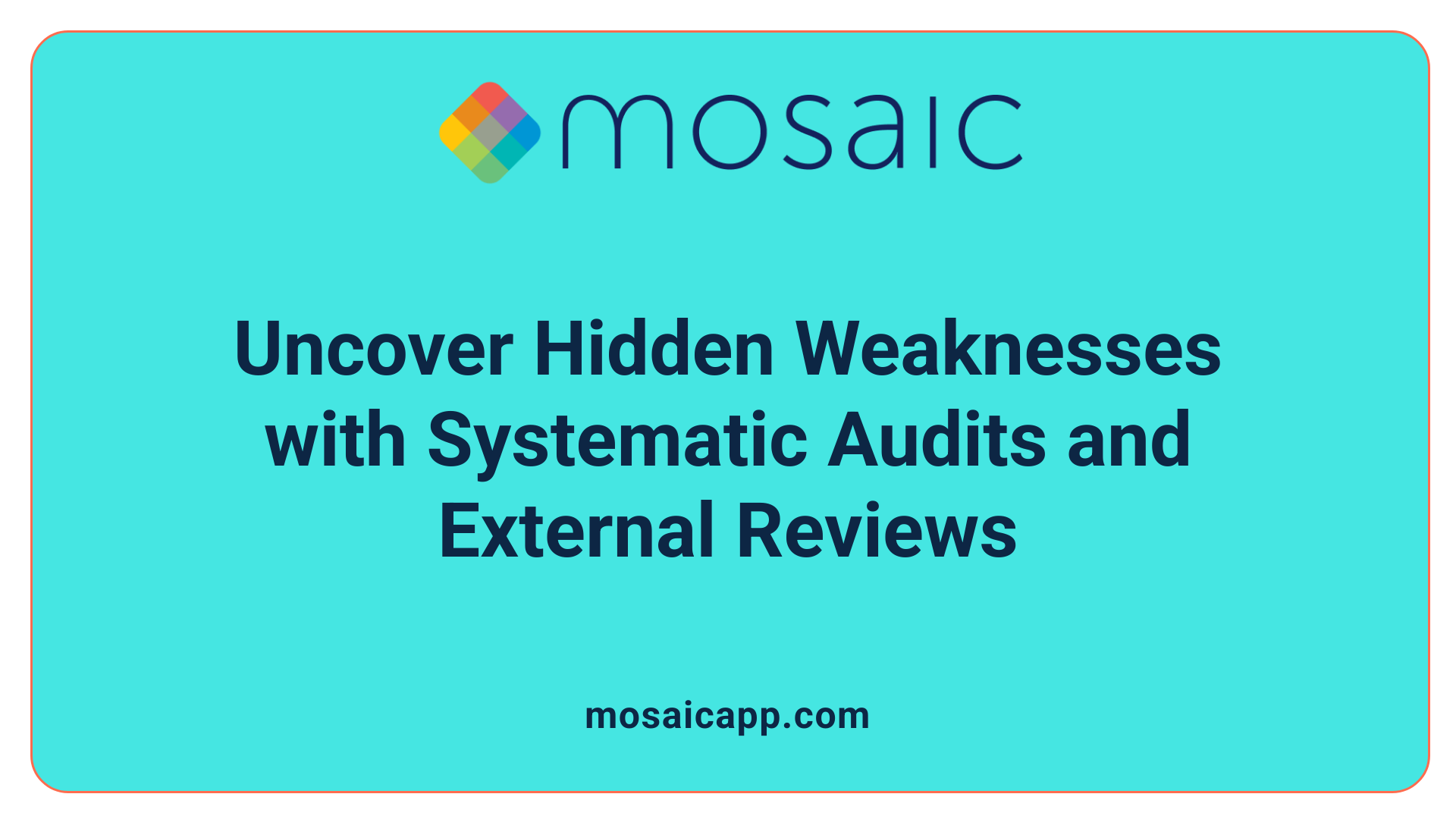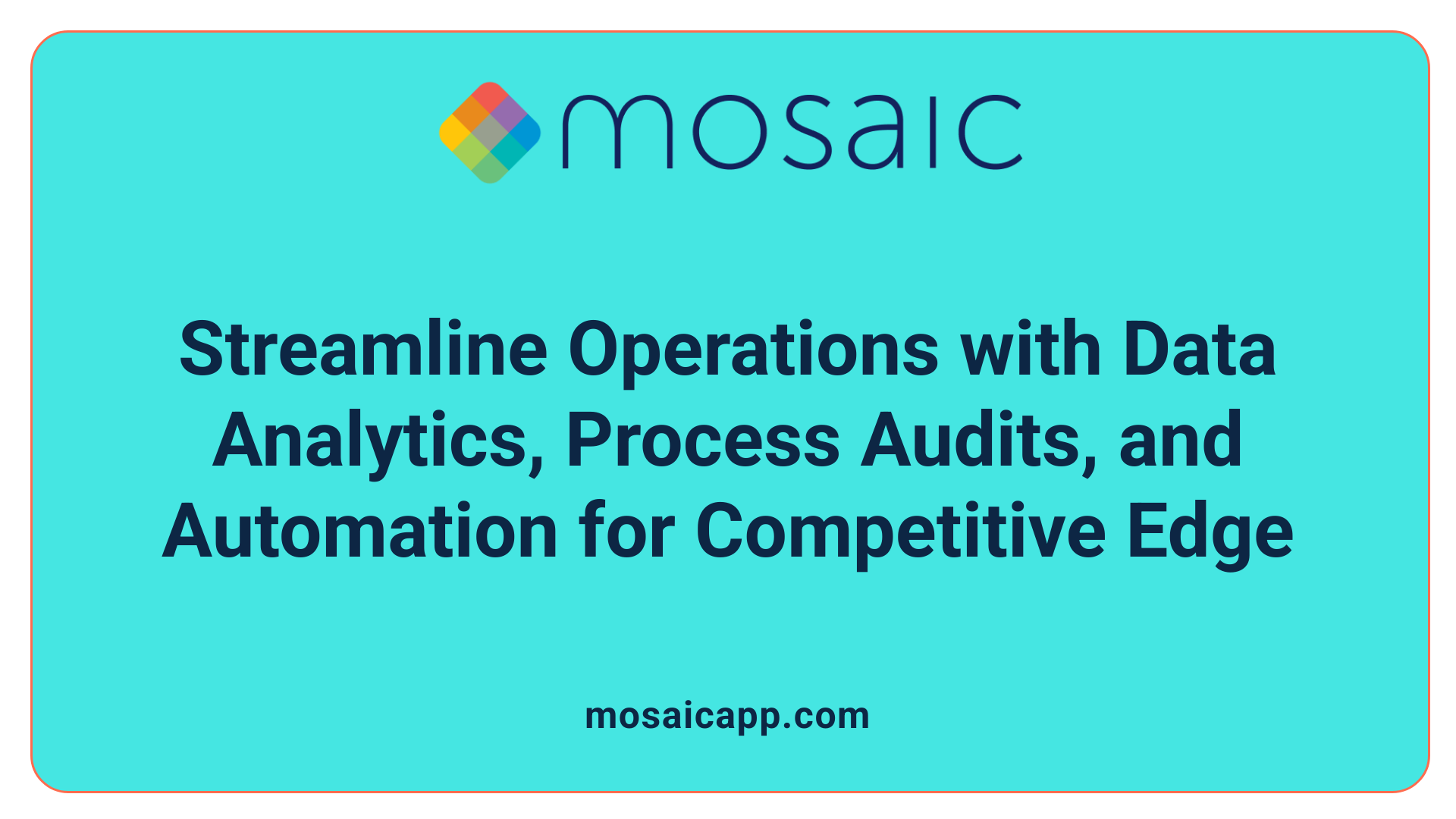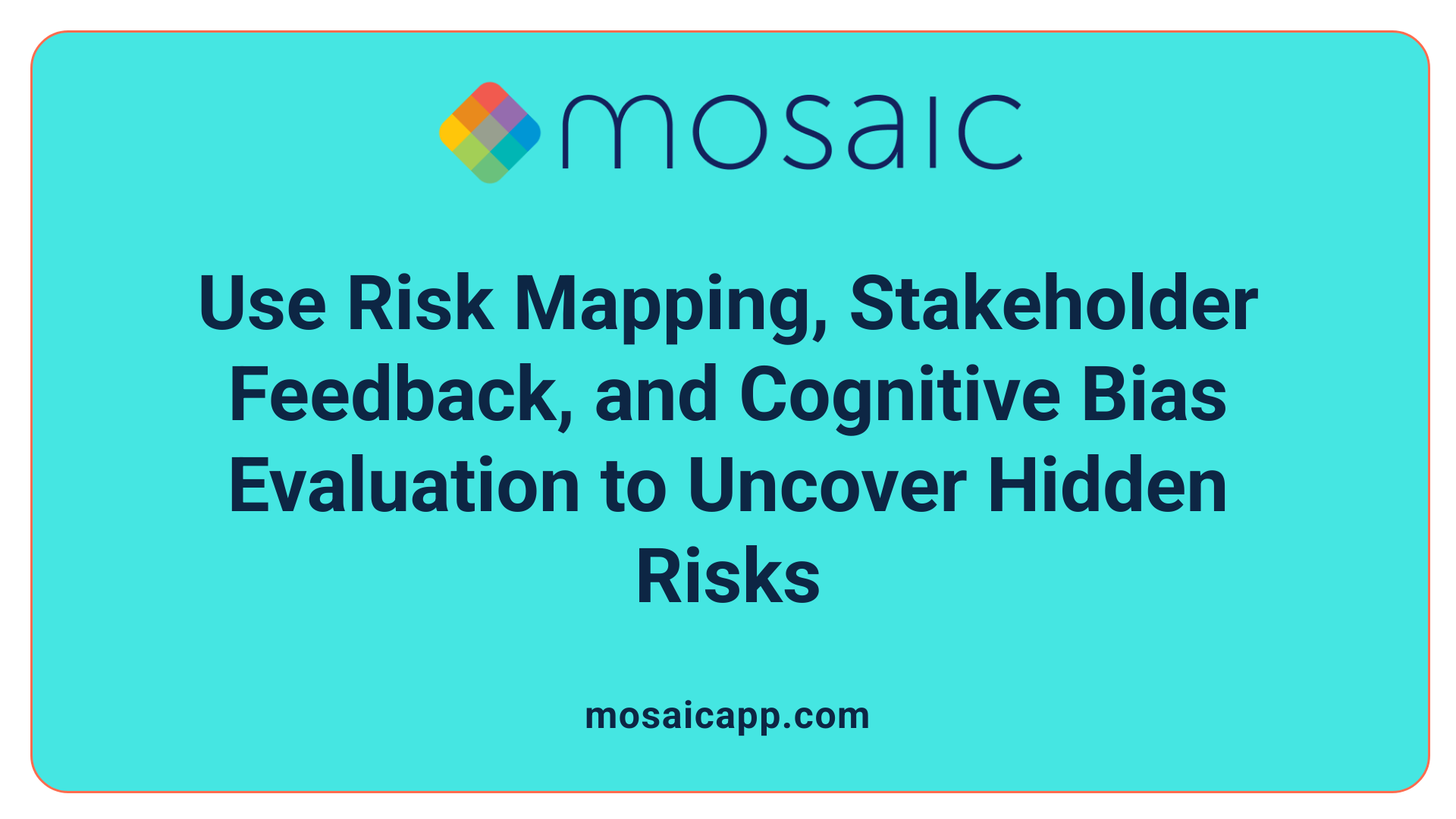Transforming Organizational Weaknesses into Competitive Advantages
In today’s fast-paced and complex business environment, organizations face numerous challenges stemming from overlooked weaknesses, or blind spots. These unrecognized vulnerabilities, whether strategic, behavioral, or operational, can significantly hinder growth, innovation, and competitive positioning. Recognizing and addressing these blind spots is essential for strategic evolution, enabling organizations to transform latent inefficiencies into opportunities for sustainable advantage. This article explores the common blind spots that threaten organizational success, methodologies to identify and analyze these gaps, and practical tools to foster strategic insight and agility.
Understanding Common Blind Spots in Organizations

What are common organizational, behavioral, and strategic blind spots that can hinder growth?
Organizations often face various blind spots that can impede their progress if left unrecognized. These weaknesses span financial, operational, behavioral, and strategic areas.
In the financial realm, practices such as poor cash flow management or overlooking profitability pitfalls can severely impact stability. Operational inefficiencies, like bottlenecks in processes or data silos, hinder smooth functioning and decision-making.
Behavioral blind spots are often rooted in cognitive biases and cultural issues within the organization. These include overconfidence, tunnel vision, and assumptions that lead to overlooking emerging risks or opportunities. Organizational culture itself may become a blind spot if it discourages open discussions or resists change, stifling innovation and adaptability.
Strategic oversight gaps include neglecting industry trends, technological shifts, or potential market expansion opportunities. Leaders may also fail to anticipate competitive movements or evolving customer needs, which can leave the company vulnerable.
A notable example of strategic oversight is the failure to recognize technological advancements such as digital transformation or artificial intelligence, which can drastically reshape an industry. Overlooking talent pipeline issues, or resisting necessary adaptations, can also limit growth.
To address these various blind spots, organizations should proactively foster diverse viewpoints, promote open communication, and conduct systematic assessments of risks and internal capabilities. Embracing agility and continuous learning are crucial for staying ahead of potential vulnerabilities.
Typical Blind Spots Across Different Organizational Domains
| Domain | Common Blind Spots | Impacts | Recommended Strategies |
|---|---|---|---|
| Financial | Cash flow issues, Profitability misjudgments | Financial setbacks, liquidity risk | Regular financial audits, Real-time cash monitoring |
| Operational | Process bottlenecks, Data silos | Inefficiency, delayed decision-making | Process auditing, Cross-departmental integration |
| Behavioral | Cognitive biases, Cultural resistance | Poor decision quality, Low morale | Bias training, Culture audits, Inclusive leadership practice |
| Strategic | Industry trend neglect, Tech stagnation | Market share loss, Competitive disadvantage | Market scouting, Tech trend analysis, scenario planning |
How Can Organizations Spot Their Hidden Weaknesses?
One effective method is Blindspot Analysis, which involves systematically auditing decision-making processes. This can include tools such as SWOT Analysis (Strengths, Weaknesses, Opportunities, Threats), PEST Analysis (Political, Economic, Social, Technological), and Value Chain Analysis.
Decentralizing decision-making and involving external reviewers can also surface overlooked issues. Conducting regular workshops and risk-mapping exercises helps reveal areas where assumptions may be flawed.
Additionally, employing technological tools like AI platforms (e.g., px IQ from Verde Group) can analyze unstructured feedback and detect emerging issues or dissatisfaction points not captured by traditional metrics.
Integrating Strategic Intelligence to Overcome Blind Spots
Strategic intelligence involves gathering and analyzing market data, customer insights, and competitor behavior to inform decision-making. Leaders who actively expand their networks and seek diverse perspectives are less prone to blind spots caused by biases or limited viewpoints.
Understanding industry shifts, technological developments, and customer needs—while continuously challenging assumptions—is essential for maintaining a competitive edge.
Final Thoughts
Awareness and deliberate auditing of potential blind spots can significantly improve decision quality and organizational agility. Implementing structured frameworks and encouraging openness to external insights help organizations navigate complex and rapidly changing landscapes.
By focusing on both internal vulnerabilities and external market signals, companies can position themselves for sustained growth and innovation in an increasingly competitive environment.
Strategies for Recognizing Strategy and Execution Blind Spots

How can organizations identify strategy and execution blind spots?
Uncovering hidden weaknesses in strategy and execution is vital for organizational success. One of the most effective methods involves conducting systematic audits of decision-making processes, often termed blindspot analysis. This approach helps highlight common pitfalls such as invalid assumptions, tunnel vision, over-confidence, and misjudged priorities.
Tools like SWOT (Strengths, Weaknesses, Opportunities, Threats) and PEST (Political, Economic, Social, Technological) analyses are crucial in broadening organizational perspectives. By systematically evaluating internal capabilities, industry trends, and external factors, these tools help reveal gaps or overlooked influences that could hinder progress.
Further insights come from detailed financial, operational, and workforce analytics. Regular review of cash flow, profitability, capacity utilization, and process efficiencies can expose hidden issues like operational bottlenecks or resource misallocations that aren’t immediately visible.
Seeking external reviews and decentralizing decision-making are practical steps to reduce blind spots. External reviews bring fresh perspectives, while decentralized decisions empower local managers to identify issues closer to the front line, facilitating early correction.
Addressing leadership blind spots requires constant assessment. Leaders should engage in ongoing evaluations of organizational culture, innovation capabilities, and digital transformations. Building a diverse leadership pipeline and embracing emerging technologies also help prevent blind spots related to rapid industry change and technological disruption.
Implementing these strategies creates a robust framework for continuous learning and adaptation. When organizations actively scrutinize their assumptions and involve multiple perspectives, they dramatically reduce the likelihood of overlooked threats and untapped opportunities.
Practical strategies and tools for blind spot detection
| Technique | Purpose | Example |
|---|---|---|
| Blindspot Analysis | Systematic review of decision processes | Identifies biases like tunnel vision or over-confidence |
| SWOT Analysis | Broad internal and external review | Highlights strategic gaps or overlooked market segments |
| PEST Analysis | External environment scan | Detects emerging trends or political shifts |
| Financial & Operational Analytics | Detects internal issues | Reveals cash flow problems or inefficiencies |
| External Reviews & Delegation | Incorporates external perspectives | Uncovers overlooked risks or opportunities |
| Continuous Leadership Assessment | Maintains strategic awareness | Detects emerging leadership or cultural blind spots |
How to incorporate continuous assessment into organizational routines
Regularly scheduled audits, leadership evaluations, and environment scans are essential. Incorporating feedback loops, involving diverse teams, and leveraging innovative tools like artificial intelligence for data analysis further enhance the detection process.
By maintaining vigilance over internal and external factors, organizations can safeguard against common blind spots — safeguarding their strategic resilience and operational effectiveness.
Transitioning from Blind Spot Recognition to Strategic Insight

How can organizations move from merely recognizing blind spots to gaining actionable strategic insights?
Turning awareness of organizational blind spots into valuable strategic insights requires a multifaceted approach rooted in self-awareness, diversity, and continuous information gathering. First, fostering a culture of self-awareness and ongoing learning among leadership teams is essential. This involves routine assessments, open feedback channels, and challenging existing assumptions to uncover hidden vulnerabilities.
Implementing scenario planning is another powerful tool. By imagining various future contexts and testing current strategies against these scenarios, organizations can reveal gaps and prepare proactive responses. Complementing this, diversity initiatives—such as inclusive hiring practices and cross-disciplinary teams—help reduce unconscious biases and offer broader perspectives, reducing the risk of tunnel vision.
Regularly gathering strategic intelligence is crucial. Monitoring industry trends, technological innovations, customer feedback, and market shifts enables organizations to spot emerging opportunities and threats early. Tools like industry reports, competitive analysis, and real-time data analytics support this ongoing process.
Encouraging open governance and expanding networks to include external experts, industry peers, and ethnographic researchers enhance insights. These diverse perspectives prevent echo chambers and foster innovative solutions.
Based on these insights, organizations should implement innovative responses. This might include product or service adjustments, new market entry strategies, or process innovations. Ultimately, the goal is to create a dynamic decision-making environment where insights from blind spot analysis directly inform strategic actions.
By integrating self-awareness, scenario planning, diversity efforts, continuous intelligence, and open collaboration, organizations can turn blind spot recognition into a strategic advantage. This approach leads to more informed processes that anticipate change and capitalize on unseen opportunities, securing sustainable growth and competitive edge.
Uncovering Hidden Inefficiencies for Competitive Growth

How can organizations uncover hidden inefficiencies and overlooked areas for gaining a competitive advantage?
Organizations seeking to stay ahead must routinely identify and address inefficiencies that may not be immediately visible. Uncovering these hidden issues requires a strategic approach combining several analytic methods.
One effective method is conducting comprehensive process audits and root cause analyses. These practices involve systematically reviewing organizational workflows to pinpoint bottlenecks, errors, and wasteful actions. By understanding the underlying causes of operational setbacks, organizations can target specific areas for improvement.
Leveraging digital tools plays a crucial role in revealing inefficiencies. Real-time data analytics, automated workflows, and communication platforms enable organizations to monitor their operations continuously. For example, data analysis can identify delays in paperwork, identify manual tasks that could be automated, and spot resource misallocations or redundant activities.
Encouraging employee feedback and closely monitoring KPIs (Key Performance Indicators) can further highlight inefficiencies. Frontline insights often reveal communication gaps, idle times, and procedural delays that broader metrics might miss. This continuous feedback loop helps organizations adapt processes in response to real-world challenges.
Addressing these inefficiencies results in multiple benefits. Automation and workflow optimization reduce hidden costs, eliminate unnecessary manual effort, and streamline customer service phases. These improvements not only enhance productivity but also significantly elevate customer experience.
An essential part of this process is not merely implementing changes but also continuously measuring their impact. Regular assessments ensure that improvements are sustained and allow for strategic adjustments as market conditions evolve.
In practice, these efforts contribute directly to a competitive edge. They enable organizations to operate more efficiently, foster innovation, and better meet customer expectations. Ultimately, uncovering hidden inefficiencies and streamlining operations support long-term growth and resilience.
| Method | Focus Area | Outcome |
|---|---|---|
| Process Audits & Root Cause Analysis | Workflow review, error detection | Identifies bottlenecks and waste |
| Digital Data Analytics | Real-time operational insights | Reveals delays, resource issues |
| Employee Feedback & KPI Monitoring | Staff insights, performance tracking | Detects communication gaps and delays |
| Implementing Automation & Workflow Changes | Process optimization | Reduces costs, improves efficiency |
| Continuous Measurement | Effectiveness tracking | Ensures sustained improvements |
This integrated approach enables organizations to proactively manage their operations, discover overlooked areas, and implement strategies that secure a distinctive competitive advantage in today's dynamic market landscape.
Methodologies for Detecting Strategic Blind Spots

What research methodologies can be used to detect strategic blind spots within an organization?
Identifying blind spots in strategy requires a diverse set of research methods that provide comprehensive insights. One fundamental approach is conducting thorough blindspot analyses through decision audits. These audits systematically review decision-making processes to pinpoint overlooked assumptions, biases, or gaps.
Structured frameworks, such as Gilad, Gordon, and Sudit's 3-step method, are highly effective. This approach involves first raising awareness of potential blind spots, then analyzing underlying assumptions, and finally adjusting strategies based on findings. This process encourages deliberate reflection on internal biases and external influences.
In addition to internal reviews, organizations should utilize tools like 360-degree feedback and performance reviews. These instruments gather perspectives from multiple stakeholders—employees, customers, and partners—to reveal overlooked concerns and divergent viewpoints.
Scenario visualization is another valuable technique. By creating detailed future scenarios, teams can explore how different developments might impact their strategies. This simulation helps expose vulnerabilities or assumptions that may not be apparent in current analyses.
Engaging external experts and stakeholders offers fresh perspectives that internal teams might miss due to organizational bubbles or cognitive biases. Their insights can reveal emerging trends or gaps in understanding.
Mapping potential risks is also critical. It involves systematically identifying and evaluating threats and uncertainties that could undermine strategic success.
Lastly, organizations should critically evaluate their strategic decisions for biases such as overconfidence, tunnel vision, or the Sunk Cost Fallacy. Recognizing these biases helps prevent persistent errors and fosters a culture open to question and revision.
Together, these methodologies support continuous learning and vigilant scrutiny of decision-making processes. They enable organizations to detect and address hidden blind spots, ensuring more resilient and adaptive strategies.
| Methodology | Description | Benefits |
|---|---|---|
| Blindspot Analysis | Systematic review of decision processes and assumptions | Reveals overlooked biases and gaps |
| Gilad's 3-Step Framework | Awareness, analysis, adjustment | Encourages deliberate reflection and strategy revision |
| 360-Degree Feedback | Multi-source stakeholder feedback | Identifies diverse perspectives and hidden concerns |
| Scenario Visualization | Simulating future scenarios | Tests resilience of strategy against potential changes |
| External Expert Consultation | Bringing in outside perspectives | Uncovers external blind spots and industry trends |
| Risk Mapping | Identifying and analyzing strategic risks | Prepares organization for future uncertainties |
| Cognitive Bias Evaluation | Examining decision-making for biases | Improves decision quality and avoids repeated errors |
In conclusion, a combination of internal audits and external insights, supported by structured frameworks and risk analysis, provides a robust approach to uncovering and addressing strategic blind spots. This multifaceted methodology promotes strategic agility and long-term success.
The Role of Tools and Frameworks in Strategic Decision-Making

What tools and frameworks can organizations develop to enhance decision-making and strategic planning?
Organizations seeking to strengthen their decision-making and strategic planning processes can leverage a wide array of established tools and frameworks. These models provide structured approaches that help analyze internal capabilities, industry environments, and growth avenues.
Among the most widely used are the Balanced Scorecard, SWOT Analysis, Porter's Five Forces, and the Ansoff Matrix. The Balanced Scorecard enables organizations to track performance across financial, customer, internal process, and learning and growth perspectives, ensuring that strategic efforts align with overall objectives.
SWOT Analysis helps identify organizational Strengths, Weaknesses, Opportunities, and Threats, providing a holistic view of internal and external factors.
Porter's Five Forces examines industry competitiveness through the lens of competitive rivalry, supplier power, buyer power, threat of new entrants, and substitute products, guiding firms on positioning and strategic priorities.
The Ansoff Matrix focuses on growth strategies, categorizing options into market penetration, product development, market development, and diversification, based on market and product axes.
To facilitate effective execution and collaboration, organizations turn to software solutions like Spider Impact, Trello, Jira, and Airtable. These tools help teams set and track KPIs, model different scenarios, and ensure operational activities align with strategic goals.
Frameworks such as Objectives and Key Results (OKRs) promote goal clarity; Scenario Planning prepares for future uncertainties by exploring various possible outcomes; Hoshin Kanri aligns strategic goals with day-to-day activities; and Gap Analysis identifies the gaps between current and desired states, guiding necessary transformations.
Analytical methods like PESTEL analysis provide insights into political, economic, social, technological, environmental, and legal external factors impacting decisions. Decision trees offer visual clarity on possible decision paths and their potential outcomes.
By integrating these models with data-driven tools and collaborative platforms, organizations can develop more informed, agile, and resilient strategies. The combination of analytical rigor and cross-disciplinary perspectives helps in mitigating blind spots and responding effectively to dynamic market conditions.
| Framework/Tool | Purpose | Application Example | Additional Detail |
|---|---|---|---|
| Balanced Scorecard | Performance measurement and management | Tracking key performance metrics across business areas | Ensures balanced focus across financial and non-financial goals |
| SWOT Analysis | Internal and external environment review | Identifying strategic opportunities and risks | Guides decision on leveraging strengths and addressing weaknesses |
| Porter's Five Forces | Industry competitive analysis | Assessing industry profitability | Helps position the organization effectively within its industry |
| Ansoff Matrix | Growth strategy development | Deciding between market penetration or diversification | Supports identifying expansion options |
| Scenario Planning | Future uncertainty assessment | Preparing for economic downturns or tech shifts | Explores multiple plausible scenarios to develop contingency plans |
| Hoshin Kanri | Strategic alignment and execution | Aligning team goals with corporate strategy | Collaborative approach to ensure focus on key initiatives |
| Gap Analysis | Performance gap identification | Transitioning from current to desired state | Pinpoints specific areas needing change |
| Decision Trees | Visual decision analysis | Clarifying possible outcomes of strategic choices | Simplifies complex decision pathways |
| External Environment Analysis | Macro trend assessment | Analyzing PESTEL factors affecting industry | Provides comprehensive view of external risks and opportunities |
Integrating these tools creates a comprehensive decision-making ecosystem. It combines quantitative analysis with strategic foresight and collaborative execution, minimizing blind spots and enhancing organizational agility.
Harnessing Blind Spot Awareness for Strategic Success
Transitioning from utilizing blind spots to generating strategic insight requires a disciplined, systemic approach. By systematically auditing decision processes, leveraging advanced analytical tools, fostering a culture of continuous learning, and embracing diverse perspectives, organizations can uncover hidden inefficiencies and unrecognized opportunities. Applying strategic foresight and comprehensive research methodologies enables organizations to proactively adapt to changing environments, mitigate biases, and extend their market and operational boundaries. Developing robust decision-making frameworks and tools further enhances strategic clarity and agility. Ultimately, organizations that consciously identify and address their blind spots position themselves for sustained growth, innovation, and competitive advantage. Recognizing that blind spots are inevitable, but manageable, allows leadership to transform vulnerabilities into valuable strategic assets, ensuring resilience and long-term success.
References
- 5 Common Blind Spots in Business and How to Overcome ...
- Industrial Talk Podcast: Eliminating Strategic Blind Spots
- Blindspot Analysis - Avoiding Common "Fatal Flaws" in ...
- From Blind Spots to Strategic Intelligence
- Biases, Bubbles, And Blind Spots In Strategic Decision- ...
- Blindspot Analysis - Avoiding Common "Fatal Flaws" in ...
- 3 Strategic Blind Spots Leaders Overlook
- 5 Common Blind Spots in Business and How to Overcome ...
- A Professionals Guide to Identifying Psychological Blindspots
- Blindspot Analysis - Avoiding Common "Fatal Flaws" in ...


